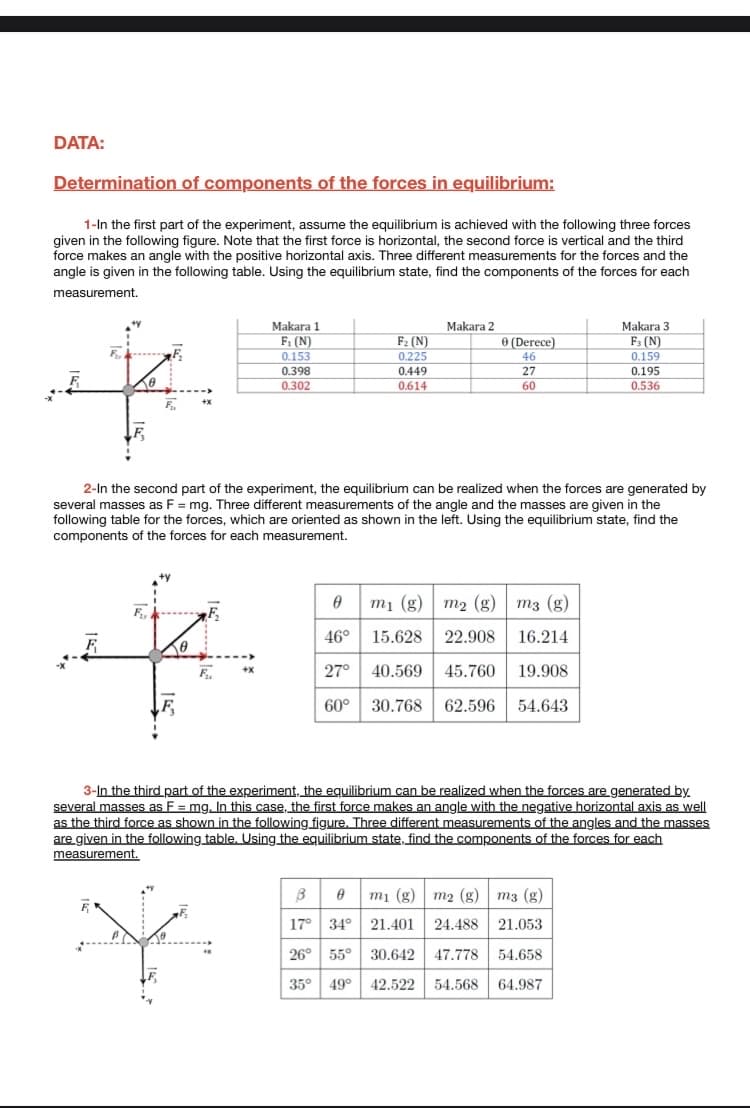Glencoe Physics: Principles and Problems, Student Edition
1st Edition
ISBN:9780078807213
Author:Paul W. Zitzewitz
Publisher:Paul W. Zitzewitz
Chapter1: A Physics Toolkit
Section: Chapter Questions
Problem 60A
Related questions
Topic Video
Question
Determination of components of the forces in equilibrium.

Transcribed Image Text:DATA:
Determination of components of the forces in equilibrium:
1-In the first part of the experiment, assume the equilibrium is achieved with the following three forces
given in the following figure. Note that the first force is horizontal, the second force is vertical and the third
force makes an angle with the positive horizontal axis. Three different measurements for the forces and the
angle is given in the following table. Using the equilibrium state, find the components of the forces for each
measurement.
F
F
F₂
Fay
F₂
Makara 1
F₁ (N)
0.153
0.398
0.302
F₂₁
F₂ (N)
0.225
0.449
0.614
Makara 2
2-In the second part of the experiment, the equilibrium can be realized when the forces are generated by
several masses as F = mg. Three different measurements of the angle and the masses are given in the
following table for the forces, which are oriented as shown in the left. Using the equilibrium state, find the
components of the forces for each measurement.
0 (Derece)
46
27
60
0
m₁ (g) m₂ (g)
m3 (g)
46°
15.628 22.908
16.214
27° 40.569 45.760 19.908
60° 30.768
62.596 54.643
Makara 3
F3 (N)
0.159
0.195
0.536
3m₁ (g) m2 (g) m3 (g)
17° 34° 21.401 24.488 21.053
26° 55° 30.642 47.778 54.658
35° 49° 42.522 54.568 64.987
3-In the third part of the experiment, the equilibrium can be realized when the forces are generated by.
several masses as F = mg. In this case, the first force makes an angle with the negative horizontal axis as well
as the third force as shown in the following figure. Three different measurements of the angles and the masses
are given in the following table. Using the equilibrium state, find the components of the forces for each
measurement.
*
Expert Solution
This question has been solved!
Explore an expertly crafted, step-by-step solution for a thorough understanding of key concepts.
This is a popular solution!
Trending now
This is a popular solution!
Step by step
Solved in 3 steps with 2 images

Knowledge Booster
Learn more about
Need a deep-dive on the concept behind this application? Look no further. Learn more about this topic, physics and related others by exploring similar questions and additional content below.Recommended textbooks for you

Glencoe Physics: Principles and Problems, Student…
Physics
ISBN:
9780078807213
Author:
Paul W. Zitzewitz
Publisher:
Glencoe/McGraw-Hill

Glencoe Physics: Principles and Problems, Student…
Physics
ISBN:
9780078807213
Author:
Paul W. Zitzewitz
Publisher:
Glencoe/McGraw-Hill